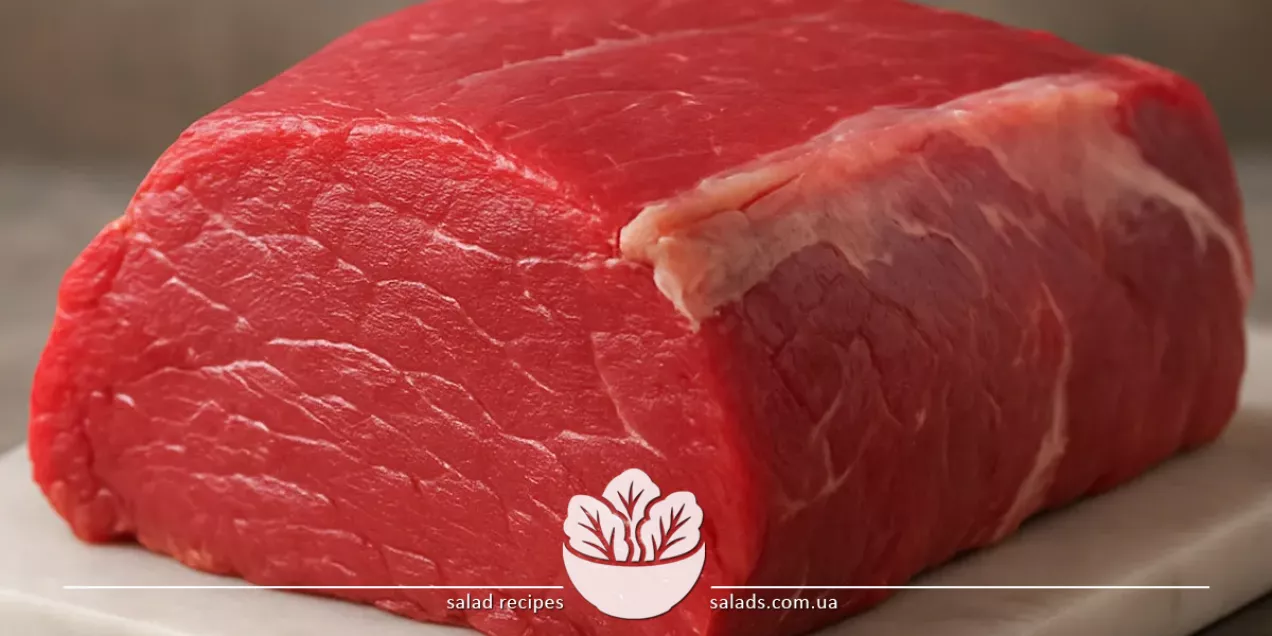Beef

Beef is the meat of cattle, known for its dense texture, rich taste, and high nutritional value. It is used in soups, stews, steaks, patties, roulades, roasts, and many other dishes. Thanks to its high content of protein, iron, and amino acids, beef supports muscle tone and promotes satiety. Different cuts vary in fat content and cooking suitability – from tenderloin to brisket. All types of beef are presented in the beef types category.
Beef Salad Recipes
Beef salads are known for their nutritional value and deep meat flavor, making them perfect for festive tables or hearty lunches. A classic example is the “Stolichny” salad, where boiled beef is combined with potatoes, pickles, eggs, and mayonnaise. Another popular option is a warm salad with pan-fried beef, onions, and spices, paired with fresh cucumber, bell pepper, and lettuce. In Georgian cuisine, a well-known salad includes beef, walnuts, and cilantro, dressed with a garlic-nut sauce. Fans of Asian flavors will enjoy a salad with thinly sliced fried beef, Korean-style carrots, soy sauce, and sesame. Italian inspiration is found in a salad with beef, arugula, Parmesan, and balsamic dressing. Thanks to its versatility, beef pairs well with both fresh and canned vegetables, offering endless possibilities for culinary experiments.
Combining Beef with Vegetables
Beef goes perfectly with vegetables, especially in stews, baked dishes, or soups. Due to the dense structure of the meat, vegetables help soften its flavor, balance fat content, and add texture to the dish. Carrots, onions, cabbage, bell peppers, and potatoes are most commonly used – they hold up well during cooking and retain their qualities. A classic example is stewed beef with cabbage. This dish has a pleasant sweet-salty flavor and is one of the most common in traditional cuisine. Cabbage softens under the influence of the meat, absorbs the aroma, and makes the beef easier to digest. White cabbage is especially suitable for such dishes. It maintains its texture even after long stewing, blending well with spices, tomato paste, and meat juices. This reliable combination is often used in daily cooking and remains timeless.
Comparing Beef with Other Meats
Beef is classified as red meat and is known for its distinct taste, dense texture, and high nutritional value. It is often compared with other meats – pork, chicken, turkey, or lamb. Compared to pork, beef contains less fat but has firmer fibers, requiring longer cooking or prior marination. Pork, especially roasted pork shoulder, has a softer texture, greater juiciness, and is easier to digest when baked. Beef, on the other hand, holds its shape better during cooking and offers a deeper flavor profile, which is particularly appreciated in steaks and soups. A comparison with roasted pork shoulder highlights differences in structure, fat content, and culinary potential. Pork shoulder works well for sandwiches and appetizers, while beef is suited for more complex hot dishes that require rich flavor and firm texture.
Alternatives to Beef in Dietary Nutrition
Although beef is rich in protein, iron, and amino acids, it may not always be suitable for light or dietary meals due to its dense texture and relatively high calorie content. In such cases, many people prefer meats with a softer texture and lower fat content. One of the most popular alternatives is chicken, particularly chicken fillet. This lean meat cooks quickly, is easily digested, and has a neutral flavor. It can be boiled, fried, stewed, or baked without losing tenderness. In dishes where beef might be too heavy, chicken fillet allows you to retain nutrition without sacrificing lightness. This choice is common in weight-loss diets, post-operative menus, or children's nutrition. Using chicken fillet as a substitute for beef is especially relevant in salads, soups, and casseroles. It supplies the body with protein without overloading it with fat or heavy thermal processing. It’s a practical option for everyday meals.
Pairing Beef with Smoked Ingredients
Beef pairs wonderfully with smoked products, which enhance its natural flavor and add depth to dishes. In recipes featuring multiple types of meat, a combination of fresh or stewed beef with smoked meats is often used to create a more complex flavor profile. This is typical for soups, stews, casseroles, and meat platters. Smoked chicken wings, with their aroma and crispy skin, create a striking contrast to the dense texture of beef. They can be served together in hot appetizers or used in complex salads and main courses. This pairing enriches the dish with smoky notes, pepper, herbs, and wood aroma. An example of such an addition is smoked chicken wings, often used as an ingredient or garnish for stewed or roasted beef. It's an excellent choice for preparing spicy, festive, or restaurant-style meals with bold character.
Organ Meats as a Complement to Main Cuts
In cooking, not only classic meat cuts matter – organ meats also play a significant role due to their high nutritional value and ability to diversify flavor profiles. One of the most valuable organs is the liver, which pairs particularly well with other meat ingredients. Its taste is pronounced, with a characteristic bitterness that balances out with proper preparation. Recipes often include combinations of beef pieces and liver – in stews, fillings, meat salads, or liver cakes. Such dishes are nutritious, rich in iron, vitamins A and B12, proteins, and enzymes essential for blood formation. When properly seasoned and cooked, both ingredients complement each other. A perfect example is beef liver. It adds depth and a mild contrast to beef, especially in dishes with sautéed onions, carrots, or cream-based sauces. This duo fits well in both traditional and modern home cooking.